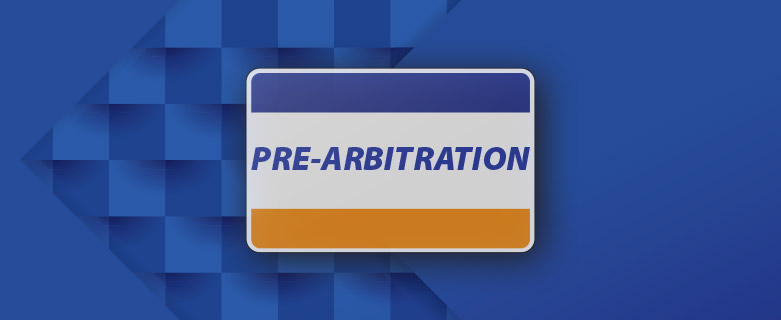News

Pre-Arbitration Rules for Visa
Traversing the maze of processing transactions requires a merchant to familiarize themselves with a vast array of terminology. Under these circumstances, it can be easy to be confused by something such as “pre-arbitration.” But make no mistake, being inadequately prepared for pre-arbitration could cost you time and money in lost payments and arbitration fees.
This article will explain pre-arbitration and guide merchants through how to handle Visa’s two-pronged pre-arbitration process.
What is Pre-Arbitration?
Pre-arbitration is, as the name implies, the last step before potential arbitration in the process of a chargeback dispute. It is essentially the final opportunity the opposing parties and their banks have to resolve a dispute before Visa steps in to render a final decision via arbitration.
The involved parties in this process are the merchant, the cardholder, and their respective banks. As a general note on terminology, “the issuer” refers to the cardholder’s bank while “the acquirer” refers to the merchant’s bank.
What Causes Pre-Arbitration?
Several possible causes may lead an issuer to file for pre-arbitration. These include a change in reason code, new information from the cardholder, a conviction that the acquirer’s evidence does not sufficiently resolve the dispute, or the issuer feels that there are terms and policies—including return policies—that the merchant did not correctly disclose during the transaction.
For Card Not Present merchants, the following Disputed Conditions are the most common that may be associated with pre-arbitration. Those codes are as follows:
-
VCR Dispute Reason Code 10.4: Other Fraud – Card Absent Environment
-
VCR Dispute Reason Code 13.1: Services Not Provided or Merchandise Not Received
-
VCR Dispute Reason Code 13.2: Cancelled Recurring Transaction
-
VCR Dispute Reason Code 13.3: Not as Described or Defective Merchandise
-
VCR Dispute Reason Code 13.6: Credit Not Processed
The reasons why an acquirer might file for pre-arbitration are explained in further detail below, where we discuss the difference between Visa’s two approaches to dispute resolution.
How Does Visa Pre-Arbitration Work?
Visa has two different dispute workflows—collaboration and allocation—that each make use of pre-arbitration in different ways.
To explain how pre-arbitration works in each workflow, it is essential to enumerate the steps between an initial transaction and an ultimate arbitration case filing for each workflow. The general dynamic of these progressions are such that each successive step after the initial presentment is a response by the opposite party to the previous step.
Collaboration
Visa’s collaboration workflow fits a circumstance in which the acquirer and issuer work together to resolve an issue with a transaction, share information, and attempting to discover the source of the issue. In a collaboration workflow, the issuer files pre-arbitration, and the acquirer must decide whether to accept or deny liability.
The process works as follows:
-
Step 1. First Presentment
The acquirer submits transaction data to the issuer to receive payment, which the issuer then remits. -
Step 2. Chargeback
The issuer disputes the transaction, and the payment from step 1 is removed from the acquirer’s account.
-
Step 3. Second Presentment
The acquirer presents evidence to dispute the chargeback.
-
Step 4. Pre-Arbitration Case Filing
The chargeback process having been completed; the issuer disputes some aspect of the second presentment.
-
Step 5. Pre-Arbitration Response
Having received the case filing, the acquirer can either choose to accept or deny liability. If the acquirer accepts liability, the process ends here. If the acquirer does not accept liability, they rebut the case and send it to arbitration.
-
Step 6. Arbitration
The issuer and acquirer each present their side of the case to Visa, who assigns responsibility. Whichever side loses is also required to pay all fees.
Allocation
The allocation workflow functions such that it uses Visa’s technology platform to allocate liability to either the acquirer or issuer. It essentially cuts the second presentment (step 3) out of the process. As a result, the dynamic is reversed from the collaboration workflow. In an allocation process, the acquirer files for pre-arbitration, and the issuer decides whether or not to accept liability.
The process works as follows:
-
Step 1. First Presentment
The acquirer submits transaction data to the issuer in order to receive payment, which the issuer then remits. -
Step 2. Chargeback
The issuer disputes the transaction, and the payment from step 1 is removed from the acquirer’s account. Visa’s system allocates liability to one party or the other.
-
Step 3. Pre-Arbitration Case Filing
If the acquirer is unsatisfied with how Visa has allocated liability, they file for pre-arbitration.
-
Step 4. Pre-Arbitration Response
Having received the case filing, the issuer can either choose to accept or deny liability. If the issuer accepts liability, the process ends here. If the issuer does not accept liability, they rebut the case and send it to arbitration.
-
Step 5. Arbitration
The issuer and acquirer each present their side of the case to Visa, who assigns responsibility. Whichever side loses is also required to pay all fees.
How Should I Respond to Visa Pre-Arbitration?
The proper merchant response to pre-arbitration depends on whether the process is following the collaboration or allocation workflow.
In the collaboration workflow, the acquirer has two possible responses to a pre-arbitration filing: accepting or denying liability. While accepting liability means lost revenue, it does prevent the possibility of incurring further costs.
Denying liability and rebutting the case does present the possibility of recovering revenue in the event that the acquirer prevails during arbitration with Visa. But this course of action also carries the risk of losing the payment AND paying arbitration fees if the acquirer loses at arbitration. It is generally inadvisable to deny liability in a pre-arbitration response unless the acquirer has reason to believe that they will prevail at arbitration.
In the allocation workflow, the merchant’s decision is whether or not to file pre-arbitration. Because there is no second presentment, the acquirer has no opportunity to dispute a chargeback. Pre-arbitration is the only circumstance in which a merchant can oppose what they feel to be an improper chargeback. As a result, there may be more circumstances in which it is advisable to pursue arbitration under the allocation workflow.
How Can I Avoid Pre-Arbitration?
Of course, the best way to handle the risks of pre-arbitration is to reduce the likelihood that your business will face it. There are proven techniques to reduce the incidences of payment disputes with customers. They include:
-
Fraud prevention solutions
Fraud comes in different forms, and not all of it is preventable, but there are tools that you can use to identify and eliminate some of the most frequent types of fraud before payments become disputes. -
Well trained customer service reps
Many disputes originate with a well-meaning but confused customer. Well trained and easily accessible customer service representatives could give these customers recourse to assuage their confusion that does not involve the credit card company dispute systems.
-
Transparency in refund policies
A particular source of confusion for customers, and thus an origin point for many payment disputes, are misunderstandings regarding refund policies. Make your refund policies accessible and easy to understand, and it will cut down on the number of disputes that lead to pre-arbitration.
-
A trusted partner
MidMetrics is the trusted chargeback business you need to handle your chargeback management to avoid pre-arbitration. We can give you the insights you need to reduce your number of chargebacks, grow your revenue, and get your merchant accounts back in order. Additionally, we offer in-depth analytics tools, a variety of integrations, an experienced team of chargeback experts, robust reporting systems, and easy-to-understand dashboards.









